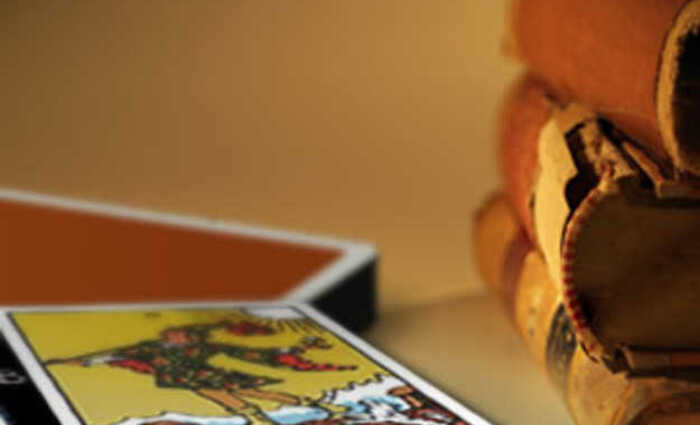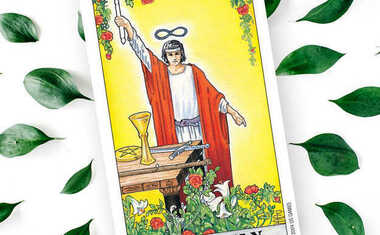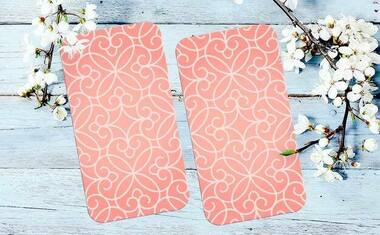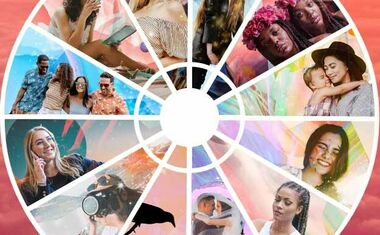
Criteria for Esoteric Tarot
What attributes constitute the esoteric tarot
The term "esoteric Tarot" defines our approach to the unfolding history of Tarot. Throughout this program, it is the key concept and watchword. So the reader can follow the discussion, I have listed the following characteristics that must be met to qualify a deck as an esoteric Tarot:
1) The Tarot must have seventy-eight cards. This is not to say there is no esoteric content in the decks with other card counts. Many decks with fifty-two cards, or those with a few more or less, reveal the inherent structure of a Minor Arcana deck and contain imagery that refers to or reflects Major Arcana themes from larger decks. One can often see a King of Cups who looks like a minor Pope, or echoes of the Justice on the Queen of Swords, for example. Other decks have extras of both the Major Arcana and the Minors to serve the needs of the game for which the decks were constructed.
The seventy-eight card deck, however, encompasses the full spectrum of correspondences that fill out an esoteric Tarot as discussed in the "Confluence of Ancient Systems" essay. A few of the odd-numbered Tarots feature royalty or Major Arcana so beautiful or magically constructed that we felt we had to include them despite eccentric numbers of Minor Arcana. But the "perfect" Tarot for esoteric work is one with seventy-eight cards containing twenty-two Major Arcana, sixteen royalty and forty suit cards. In this way you get the full Hebrew/Greek alphabet, the Kabbalah Tree in each of the four directions, the twelve signs of the zodiac in the Kings, Queens and Horsemen, and four Pages to mark the solstice and equinox points at the cusps of the seasons. Having fewer cards forces us to drop the zodiac angels that align with the numbered suit cards. Extra cards are either redundant or change the system the Tarot was designed to express.
2) An esoteric Tarot is literate. It demonstrates the hallmarks of its creator's exposure to the archetypes behind the modern forms of the Arcana. At very least, it signals awareness of the historical stream of images from which our modern decks emerge. It must be grounded to some extent in the intergenerational conversation about these timeless archetypes which has been passing from century to century. This is not to say there is no place for entirely "new" decks, because some of the modern Tarots have reinvented the medium for wonderful, rich new uses. (In particular, I refer to Isha Lerner's therapeutic Inner Child Tarot, which has been translated into fifteen languages because it is so helpful to counselors of children and teens worldwide. Also note the Alchemical Tarot, entirely without Hebrew, Greek, astrology or any other controversial matter, but which provides a treasure trove of Renaissance imagery culled from alchemical journals of the period.) I celebrate the creativity that reformats Tarot for modern needs and uses, and many modern Tarots share space with the research decks" on my Tarot table.
Unless Tarot authors make their affiliation with the ancient esoteric paradigm clear and detailed, however, their Tarot decks cannot be rightly called esoteric decks. They may be fabulous catalysts for intuition and deep emotional healing, they may be an innovative synthesis of modern themes, but they are not "the flash cards of the Mysteries."
In the course of this text we have laid out several different avenues whereby the relevant Greek, Egyptian and Hebrew symbol systems could have seeped into Europe in the centuries before Tarot appeared in card form. Tarot decks are the flash cards for this ancient worldview. The proofs are everywhere that the Hebrews, Pythagoreans, Christians, Moslems, alchemists and Rosicrucians were mining the same vein. In other words, the cards did not appear first and the esoteric correspondences second. Historically, the correspondences came first and dictated the structure of the Tarot deck. If a person has created a "Tarot" that ignores this inherent, innate historical foundation, then by definition that Tarot is not esoteric.
No one can know how many layers of meaning we will ultimately discover to be hidden in Tarot's structure, but it seems reasonable that a Tarot created to be used to its fullest will be designed with respect for the known history of this tradition. It will show Hebrew letters on the Major Arcana, the matching letters from the Alphabet of the Magi, or the matching Greek letters in order to establish a base upon which to place the related astrology correspondences. It will give us enough clues in the art and titles to declare its "pedigree," the historical stream from which it is quoting, if there is one. The presence of signs and planets could be optional if the other details are arranged consciously.
If any authors depart from the historical Hebrew, Alexandrian or French esoteric correspondences (for example, into one of the "modern traditions" like that of Dali or the English Magikal Tarot, which is the most well known contemporary pattern), they would do us all a favor to publish a complete table somewhere in their support material to delineate exactly what set of correspondences they are following. It would be wonderful if Tarot creators felt more obligated to research and explain where their images and correspondences came from and/or the idea motivating their emergence. There is nothing dishonorable or demeaning in saying "I am doing this on my own authority. I made these images and correspondences up myself." We who care about these simply want to know what the correspondences are so we know what we are working with when we pick up a deck.
It seems inevitable that there will be more true and authentic "ancient lineage" material yet to appear in the future as scholars sort out and date the various cultural strata included in the Tarot, even as it first appeared in the 1450s. Now that we can more clearly differentiate the truly ancient Hebrew and Hermetic/ Alexandrian Mysteries of the handmade and woodblock Gnostic Tarots, the Renaissance Christian Cabbalist Mysteries of the Continental school, and the "modern Magikal Mysteries" of the English school, we can make even fuller use of the treasure trove of esoteric lore left us by our illuminated ancestors, both ancient and modern.
The Minor Arcana should also show forthrightly their correspondences to signs or zodiacal degrees. It is helpful if the author makes it clear how they are treating the 5- degree angels of the Shemhameforesh. It is so much easier to work with a Tarot whose authors respect the built-in symmetry between the Major Arcana and the Minors, being conscious of the traditional Mysteries of the Decave when constructing their numbered suit cards (see the essay on The Minor Arcana).
3) Esoteric Tarots attempt to universalize rather than particularize. Beyond being founded upon or linked to either one of the three very closely related ancient lineages (which hopefully will be explicitly represented on the faces of the cards), or one of the "modern traditions" which have become elaborated for the twentieth century, esoteric Tarots are designed to be a scientific tool for examining energies, situations and psyches. They report without judgment. Like a microscope or a set of measuring devices, Tarot is impartial. It works best when it does not inflame the emotions overmuch or induce such flights of fancy that one cannot deduce practical instructions from its use. An excess of fanciful speculations can obscure the dynamics the card was created to reveal in its number/suit identity.
The images which have in this century become associated with the Alexandrian astro-alphanumeric correspondences make little use of elaborate art or brilliant color, avowedly because such embellishments influence us emotionally and affect our powers of judgment.
As flash cards, Tarot was made to hold layers of meaning condensed into cryptic symbols arranged in meaningful patterns. Those symbols have standard meanings which are geometric, astrological and alphabetical. They are not designed for "free association" but for calculation, like the equations that make sense of your tax statements or determine the placement of the beams that hold up your house. Their original meanings were not based on the "opinion" of any Tarot author, but were built upon the principles of numbers, suits and alphabet.
For this reason, traditional esoteric Tarots do not usually show human images on the numbered suit cards. When the principle represented by a given card's place in the grid (see various graphs and tables) is illustrated with a human personage, the understanding of that card can be diminished. This is not such a drawback in respect to the royalty cards because those cards were originally designed to carry the personalities of the related zodiacal signs. But the numbered suit cards are not people cards. They represent the play of forces and circumstances impacting human lives and the best strategies for not being swept away by them. They denote esoteric equations, not personalities.
In terms of the modern, fully illustrated Tarots, instead of being shown the formula that represents a certain natural law operating at a certain stage of the cycle in a distinct elemental realm, the Tarot user encounters a cartoon of people enacting specific behavior and undergoing a particular emotional experience. This overemphasizes the emotional content among the possibilities of meaning and interpretation for that card. The resulting reductionism has happened throughout the Major and Minor Arcana over the centuries. Although a case can be made that Tarot needs to be allowed to change and evolve, each such departure takes a deck further and further from being an esoteric Tarot. I do not mean to say that fully illustrated Tarots are a bad development in the history of Tarot, only that they can easily obscure the underlying grid with too much editorializing. This all too human tendency is out of harmony with traditional esoteric Tarot design principles.
Read more excerpts from The Underground Streams: Esoteric Tarot Revealed:
History of Tarot | Esoteric Origins of Tarot | Criteria for Esoteric Tarot | The Gnostic Tarot | Kabbalah | Confluence | Continental Tarots | Spanish School | The English School | Major Arcana Theory | Minor Arcana | Major Arcana Cards | Coins | Cups | Swords | Wands



